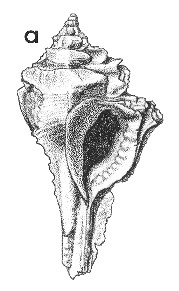
Revised descriptions of New Zealand Cenozoic Mollusca from Beu and Maxwell (1990)

 | Revised descriptions of New Zealand Cenozoic Mollusca from Beu and Maxwell (1990) | 
|
  (Pl. 30a): GS12142, D45/f05, Waiau River, upstream from Park Bluff, Clifden Section, Southland, Waiauan (GNS) |
Beu & Maxwell (1990): Chapter 13; p. 263; pl. 30 a.
Synonymy: Pterynotus laetificus Finlay 1930b, p. 76; Pteropurpura laetifica
Classification: Muricidae: Muricinae
Description: Moderately large for genus (height 65 — 80 mm), broadly fusiform, spire 0.3-0.4 total height. Protoconch narrowly dome-shaped, of about 1 smooth whorl. Teleoconch of 7 whorls, weakly subangled near middle on most shells, but more distinctly shouldered on others, including figured specimen. Thin, elevated varices spaced a third of a whorl apart, each fused to the one above to produce 3 continuous wing-like keels down the teleoconch. Varices almost flat-faced with rounded outline in some shells, but with prominent peripheral gutter and consequently triangular outline in others. Other axial sculpture of single low peripheral nodule between each pair of varices. Spiral sculpture on most specimens of weak, well-spaced cords which extend onto backs of varices (and are expressed on the front faces as shallow grooves), apparently obsolete on most of neck. Well preserved shells with very fine striae over much, if not all surface. Aperture elongate-ovate, constricted anteriorly; siphonal canal long, straight, apparently completely or almost completely closed in adults. Inner lip callus moderately thick, smooth, outer margin slightly raised anteriorly. Outer lip flared and fused to face of terminal varix, denticulate within, some shells with a distinct gutter corresponding to variceal spine.
Comparison: Pterynotus laetificus is interpreted in a broad sense, following Beu (1970b, p. 135-138), although the available specimens vary considerably in the shape of the varices, the disposition of the peripheral spine (if present), and the strength of the spiral sculpture. In some shells (including the poorly preserved holotype) the outer lip is rounded, without any obvious trace of a gutter or channel on the shoulder, although the varix has a distinctly triangular outline; in others (including the near-topotype illustrated here) there is a distinct gutter in the outer lip and a well developed peripheral spine; in yet others (e.g. from Awamoa Creek) the varices are rounded, but there seems to have been a narrow, curved canal fused to the edge of the varix on the preceding whorl. Most specimens have weak spiral sculpture, but in a shell from Trig Z, Otiake (Waitakian) (Beu 1970b, pl. 1, fig. 1, 3) the spiral cords are exceptionally strong and frill the edges of the varices. Considerably more material will be required before it can be decided if these specimens are merely variants of a highly variable species, or if more than one species is involved. Beu (1970b, p. 135-141) referred Pterynotus laetificus to the ocenebrine genus Pteropurpura Jousseaume, 1880 because of its resemblance to the Australian Recent species P. bednalli (Brazier), and recognised two additional subspecies (regarded as species by Beu & Maxwell 1990), P. flemingi (Mangapanian/Nukumaruan, Palliser Bay and Recent, northern New Zealand) and P. waiareka (Kaiatan, Lorne, Oamaru). Ponder (1972b, p. 217), however, has shown that P. bednalli has radular and opercular characters like those of typical species of Pterynotus, suggesting that P. laetificus and its relatives should be retained in Pterynotus, even though they are not particularly like the type species, P. pinnatus (Swainson, 1822) (Recent, Indo-Pacific). Vokes (1971a) also catalogued the New Zealand species in Pterynotus (sensu stricto). P. flemingi is very similar to P. laetificus, but seems to reach a smaller size and to have a more prominent intervariceal tubercle and a lower spire. P. waiareka was based on a single, poorly preserved specimen differing from typical P. laetificus in its more slender shape and much stronger spiral sculpture. P. kaiparaensis (Otaian, Pakaurangi) is rather more distinctive, differing from P. laetificus in its much smaller size (height about 30 mm) and in having three elongate nodules in each intervariceal interval.
Pterynotus is one of the most ancient genera in the Muricinae, with a record extending back to the Paleocene (Vokes 1970a, p. 2). Although it was widely distributed during the Cenozoic, modern species are restricted to subtropical and tropical regions, usually in moderately deep waters. The earliest occurrence we are aware of in New Zealand is from Meyers Stream, upper Waihao Valley (Mangaorapan-Heretaungan), collected by P. A. Maxwell. P. laetificus seems to have ranged across the shelf and into the upper bathyal zone, but P. flemingi is restricted to the deeper part of this range.
Distribution: Kaiatan?, Waitakian-Kapitean; "Clifden, band 7C, close to band 8" (type — probably from one of the Nissen Shellbeds i.e., Waiauan). Recorded from numerous localities throughout New Zealand, but nowhere common. A small shell from McCulloch's Bridge (Kaiatan) closely resembles younger specimens assigned here, and a moderate-sized one from Meyers Stream, upper Waihao (Mangaorapan-Heretaungan) is also very similar.
Cite this publication as: "A.G. Beu and J.I. Raine (2009). Revised
descriptions of New Zealand Cenozoic Mollusca from Beu and Maxwell (1990). GNS
Science miscellaneous series no. 27."
© GNS Science, 2009
ISBN
978-0-478-19705-1
ISSN 1177-2441
(Included with a PDF facsimile file
copy of New Zealand Geological Survey Paleontological Bulletin 58 in CD version
from: Publications Officer, GNS Science, P.O. Box 30368 Lower Hutt, New
Zealand)